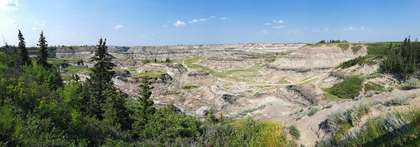
The first time we inquire about a place to pitch our tent, we again experience the downright friendliness of the Canadians. Not only is this no problem at all, of course. No, we are also invited by Norman and Dawn to join the annual family celebration - Christmas in August, with several days of camping. Three days fly by with an intergalactic championship in giant washer throwing, a comparative degustation of Dutch and local pancakes and an endless array of other delicacies. Conversations with such an unusual number of people, singing around the campfire, a traditional trash swap game and last but not least: a helicopter flight!



The inefficiency of these machines is simply absurd - in just under an hour of fun flying, we use as much energy as our bike motor has converted over the last 20,000 km - or with which an average car would travel around 400 km. Nevertheless, for us it is an opportunity that probably comes once in a lifetime and is definitely a joy! Seeing the landscape from above opens up a whole new perspective. Maybe one day I’ll get around to looking into halfway acceptable approaches like electric delta gliders…? In any case, thanks for the flight, Camiel, and thanks to everyone for the great time with you!
The Rocky Mountains gradually taper off into hills and ever smaller bumps. Endless rapeseed fields, interspersed with wheat and grassland, which over time becomes more and more prevalent. Not with cows on it, most of the grass is silaged or made into hay and rolled into bales. At some point the landscape is just flat, cleared out, with the occasional hill for variety. Alberta is the fossil province of Canada, in two respects. Almost all coal, oil and oil sands were and are mined here, and large areas of land in the north have been dug up. In the process, spectacular dinosaur skeletons and bones are constantly being discovered in the millions of years old biomass. They can be admired in an impressive exhibition at the Drumheller Museum on the Red Deer River, set in the middle of the Canadian Badlands.


We fly over the prairie with a tailwind - or fight hard when the direction turns and our path leads a little south. Smoke from the forest fires in British Columbia darkens the sky. Jannik, our travel companion in Banff, was surrounded by fire in Jasper and had to hitchhike back to Calgary. Fortunately, we are already out of the region and can only guess the extent of the fires from the red moon and the smoke-darkened sun 500 km further on. Overwhelming.

In search of variety in the sea of grasses, we take a detour to the south, to Cypress Hills. A region with history: the North West Mounted Police were founded here to combat the alcohol trade and the associated problems after a massacre of indigenous people. In contrast to the US cavalry, the Mounties were apparently held in high esteem by the Native Nations, as they not only enforced the laws and territorial claims of the young state, but also offered protection against attacks and demonstrated a sense of justice - for all sides. After the Battle of the Greasy Grass / Little Big Horn, Sitting Bull sought refuge with 5,000 Sioux around Fort Walsh and on the Frenchman River… and had to give up and accept a US-treaty a few years later despite unauthorized acquiescence on the part of Commander Walsh. In Canada, the bison were almost extinct due to overhunting; without this foundation of life, the lack of resources and hunger became too great to bear.
On the 47th parallel - formerly called the Medicine Line by the Lakota, since this invisible border ‘magically’ stopped the US soldiers and made them turn around - lies Canada’s sole national park in a reasonably pristine prairie landscape. A hike reveals an astonishing biodiversity: dozens of different grasses, lichens and other plants find their niche, and the countries only colony of black-tailed prairie dogs, a marmot-like rodent, spans an extensive network of tunnels. Our special highlight, however, is the bison. We observe the mighty creatures at a respectful distance; a herd of around 500 animals has been reintroduced here and maintains the original landscape as it was over a hundred years ago.

Towards the east, the plain becomes - it’s hard to believe - even flatter. From village to village we are accompanied by the saying: when you get to … the cycling will be great. There are no more annoying climbs there! What climbs, we ask ourselves? Towards the end of Saskatchewan, and even more so in Manitoba, the scenery becomes noticeably more varied again. In addition to grass fields, wheat appears, yellow-flowering rapeseed can be seen from time to time, sunflowers, soybeans and the occasional wood or swamp as well. We gradually leave the prairie, and soon even Canada for a while. Our route leads south of the Great Lakes into the Rust Belt, the three swing states in the north-east of the USA, which may soon play a key role in the battle between Harris and Trump.

















